Future Boat Builders
by Dave Black
Continued
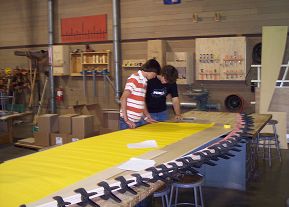 Fig 1 Making patterns and gluing the frames
for the outside curves of the boat. Fig 1 Making patterns and gluing the frames
for the outside curves of the boat. |
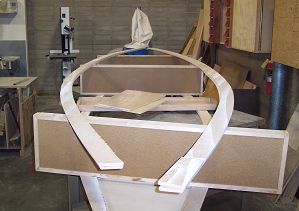 Fig 2 The outside frame of the boat. At
this point, we are planning depth. We want it pleasing to the eye as well as
functional. This means a lot of "looks good to me" type
designing. Fig 2 The outside frame of the boat. At
this point, we are planning depth. We want it pleasing to the eye as well as
functional. This means a lot of "looks good to me" type
designing. |
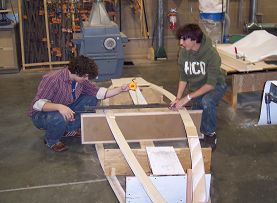 |
Fig 3 Sometimes there is a difference between what looks good on paper vs. what it really looks like. We narrowed the frame down from the original intent and tried to make it look symmetrical. We wanted the boat to be small enough so that it could be lifted by two people and transported in the back of a pick up bed. We also wanted it to be able to be stored in a garage where it could be lashed to the garage rafters and out of the way. |
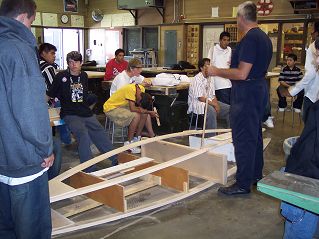 Fig 4 Here I point to a full sized drawing,
then point to the frame being built. It is sometimes frustrating to see some
fall asleep, or not care about learning. Then there are those that the light
turns on and the dreams of " I can build that" flash in their mind.
The ones that I see that are the most successful, are those who work with their
dads. The skills that are learned at home are easily seen in the shop. I am
constantly amazed at how much family culture transforms kids at school.
It's not intelligence or natural ability that is most important. It is
family values. Fig 4 Here I point to a full sized drawing,
then point to the frame being built. It is sometimes frustrating to see some
fall asleep, or not care about learning. Then there are those that the light
turns on and the dreams of " I can build that" flash in their mind.
The ones that I see that are the most successful, are those who work with their
dads. The skills that are learned at home are easily seen in the shop. I am
constantly amazed at how much family culture transforms kids at school.
It's not intelligence or natural ability that is most important. It is
family values. |
We went through design with the idea that a wave hitting the front of the boat would cause the front to float into or on top of the wave. A curved bottom would allow for the boat to pivot at the midpoint. We hope that the boat will "rock" over waves rather than "plow" through them. I tried to bring the basic classes along in design, showing them the full sized layouts we did in the advanced class and comparing them to the frame.
One of the things that I have to remember as a teacher is that some kids have never held a hammer, never sawn a board, do not know how to measure, divide fractions… To them this is all brand new. You tell these students about an idea, but they have to see it. They cannot imagine or plan in their head or on paper. They have no idea about scale or representational drawing.
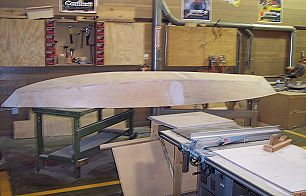 Fig 5 (side view) Fig 5 (side view) |
|
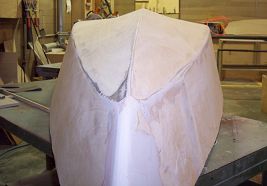 Fig 6 (front view) |
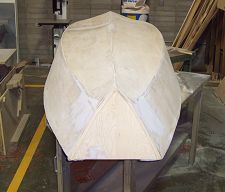 Fig 7 (stern view) |
The goal is to make a mold of this form. Once the mold is made, a fiberglass lay up can be made without the effort of building a boat every time. The student can then fit in the wooden parts and support structure during the winter and by spring have a boat complete before the end of term.
Often big projects like this are started but not completed. An incomplete project often lays around the shop or in the family garage until it is thrown out or broken down to be reused by other students. With a mold, the student should be able to easily build a boat within a semester with time to spare. It is hoped that a student can build one boat that he can sell the first semester for the materials to build a boat for himself the second semester.
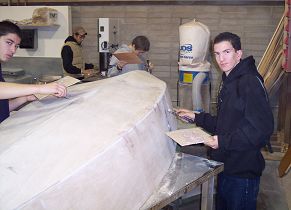 Fig 8 Shows a few of the kids from Basic Woods
working on the boat. I have a class of 22 to 24 students. I get about four
students out of the 24 who really want to pick up wood working as a hobby or a
career. Fig 8 Shows a few of the kids from Basic Woods
working on the boat. I have a class of 22 to 24 students. I get about four
students out of the 24 who really want to pick up wood working as a hobby or a
career. |
In most schools, only 12% to 15% of the kids will go on to a four year college to continue their education. These numbers are based on the requests by students for transcripts to apply for college. A student cannot be accepted by a four year college without high school transcripts. It should be remembered that this 12% to 15% is only the number that apply to a college, not the number that are accepted nor the number of students that graduate from a four year institution. We need to give this majority of students that don't go to college the tools to make a living and live a productive life.
In California, many schools are dropping the shop classes. It is assumed that the purpose of high school is to give the students the skills to go to college. It is assumed that most will attend. We need to teach non-college bound students useful skills that will allow them to live their life with dignity. It is time to re-think wood shop and other industrial arts classes; they should be a place where all the knowledge learned in the academic classes is applied. Maybe we won't hear questions like, "why do I need to learn this?", when our students have been given a place to put their knowledge into practice.
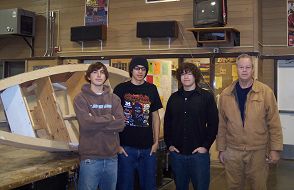 Dave Black with
future Glen-L customers. Dave Black with
future Glen-L customers. |
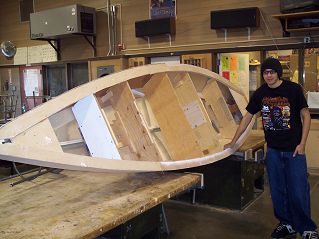 |
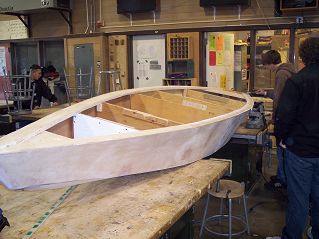 |
|
Pilot project - Independent Study in Structural engineering
I want to "raise the bar" in wood shop as well as increase student population. This means pulling from a segment of the student population that would not normally take wood shop. The student population that I am looking at are the "Calculus kids; in particular, the gifted of the "Calculus Kids".
In talking to the Math department, there are some kids that are not being challenged by Calculus. While other kids are struggling in class, these kids are skipping class, reading other books and still pulling out A's in testing.
We are going to try to pull these kids out of math class one day a week and have them apply the math that they have learned to the design of a boat. While they are gone from math, the other students can review the precepts of Calculus with more individualized help from their instructor.
The introduction of the Calculus Kids to the Advanced Wood shop will hopefully introduce Math to the wood shop students. It is hoped that this introduction through association will open the doors of interest that cannot be opened by a formal class or a professional teacher. It is also hoped that the Calculus kids would consider wood shop as an elective that they would not have considered before.
The independent study would provide a portfolio of structural design that could be shown for entry into a prestigious engineering college. It would also be a mechanism for proof of course work.
Footnote to Glen-L
High school wood shop is a seed bed for future
craftsman. I assume that many Glen-L builders are retired craftsman who want to
see this 'passing of the baton' to the next generation. Our education
system has forgotten that there is a need for craftsmanship within our society.
They train students for college, not skilled trades. I did go on to college and
had a career in the computer industry, but it was the love of the high school
wood shop that I returned to. One has to remember that these kids may have
desire, but no skills, that's why they are taking the class. From a
buisness point of view, the desire to build a boat is fostered by having skills
needed. Hopefully I am building desire.
Dave Black
Dave Black is a High school wood shop teacher Los Banos, CA.